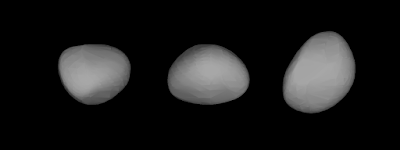Asteroid 15 Eunomia will reach opposition (the point at which it is directly opposite the Sun when observed from the Earth) at 9.34 pm GMT on Thursday 21 January 2021, when it will also be at the closest point on its orbit to the Earth, 1.56 AU (i.e. 1.56 times as far from the Earth as the Sun, or about 233 273 000 km), and be completely illuminated by the Sun. While it is not obvious to the naked eye observer, asteroids have phases just like those of the Moon; being further from the Sun than the Earth, 15 Eunomia is 'full' when directly opposite the Sun. As 15 Eunomia is only about 268 km in diameter, it will not be visible to the naked eye, but with a maximum Apparent Magnitude (luminosity) of 8.37 at opposition, it should be visible in the Constellation of Cancer to viewers equipped with a good pair of binoculars or small telescope.
The orbit and current position of Asteroid 15 Eunomia. In The Sky.
15 Eunomia was discovered by Italian astronomer Annibale de Gasparis on 29 July 1851. The number 15 implies that it was the fifteenth asteroid discovered, and it was named Eunomia after the Greek goddess of the same name, who was goddess of law, good governance, and green pastures. It is also sometimes referred to as 1851 OA, implying the first asteroid (asteroid A) discovered in the second half of July 1851 (period 1851 O).
15 Eunomia has an 1570 day (4.30 year) orbital period and an eccentric orbit tilted at an angle of 11.8° to the plane of the Solar System, which takes it from 2.15 AU from the Sun (i.e. 215% of the average distance at which the Earth orbits the Sun) to 3.13 AU from the Sun (i.e. 313% of the average distance at which the Earth orbits the Sun). As such it is considered to be both a Main Belt Asteroid (an asteroid that is between 2.06 and 3.27 AU from the Sun and has an orbital eccentricity of less than 0.33 and an inclination of less than 20°), and a Eunomia Family Asteroid (an asteroid with an average distance from the Sun of between 2.54 and 2.72 AU, and which has an orbital eccentricity of between 0.121 and 0.180, and an orbital inclination of between 11.60° and 14.8°). Members of the Eunomia Family are S-type (stony) asteroids, which are thought to have derived from a single body shattered by an impact at some point in the past.
15 Eunomia is the largest of the Eunomia Family Asteroids, with estimated dimensions of 357 × 255 × 212 km, making it between the 8th and 12th largest body in the Asteroid Belt (there is some doubt over the measurements) and giving it around 1% of the total mass of the Asteroid Belt. It's surface is comprised largely of silicates, with some nickel, and appears to show regional differentiation, with a large, pyroxene-poor, metal-rich, olivine-dominated region and a smaller pyroxene-richm generally basaltic region. This is thought to be indicative of 15 Eunomia representing the core of the original body from which the Eunomia Asteroids were formed, and that body having been large enough to have undergone differentiation due to internal heating,
See also...



Follow Sciency Thoughts on Facebook.
Follow Sciency Thoughts on Twitter.





